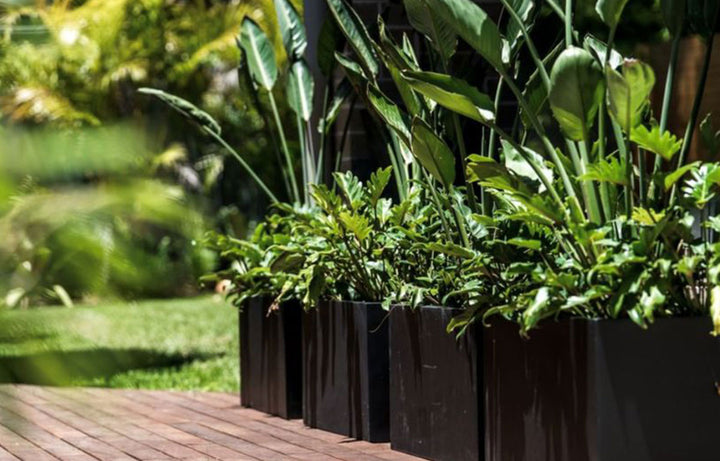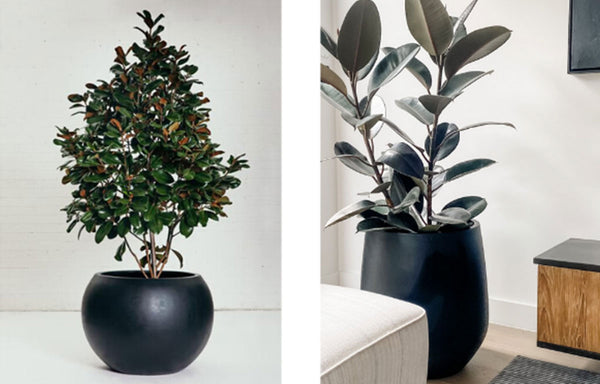
An Expert’s Guide to Styling Your Home or Balcony with Plants
An Expert’s Guide to Styling Your Home or Balcony with Plants
Greenery breathes life into a space, creating texture, colour and shape. We speak to plant styling expert Georgina McBride from Living Areas who shares her top tips for styling your space with plants.
Outdoor feature plants for balconies
Georgina’s favourite statement plants for a balcony are Birds of Paradise (Strelitzia nicoli) or Dragon trees (Dracaena draco). Their tall features always stand the test of time, can tolerate the harsh sun and look great on their own or in a cluster. Also depending on the space and existing garden one of her all-time favourites is the spectacular Olive tree. Team this beauty with a white pot like the JITT or Muffin Top, and it always looks elegant.
The Olive Tree loves the sun, so this plant is perfect for an exposed balcony space. For feature plants, Living Areas recommend a 45-litre pot size as this gives you the height and a well-established plant the chance for a longer-lasting life.

Outdoor feature plants for the front patio
Nothing looks more inviting than a plant at your front door to welcome guests For this area Georgina loves using a feature Magnolia grandiflora (Teddy Bear) or Rubber Tree (Ficus elastica burgundy) as she finds homes generally have more shade around the front door which means the plants are slightly more protected from the elements.
These plants are a beautiful statement for the entrance with their glossy leaves and beautiful structure. In an area that is not full sun, we team the feature Magnolia Teddy Bear with a Rubber Tree (250ml - 300ml) with a Jade Plant (Crassula ovata). They always make the perfect cluster for an entrance or outdoor entertaining space.

Indoor feature plants
Georgina’s favourite feature plants for inside are the Rubber Tree and Fiddle Leaf Fig (Ficus lyrate). Team these amazing plants with either a basket or a sleek pot and shazam! Plant perfection right there. They require less maintenance and prefer a light spray rather than a whole heap of water making it a great indoor plant.
Top tips for assessing your space, ready to style
Assess how you would like to furnish the space or how you have utilised the space with your existing furniture. The greenery should accompany the space, not take over.
If you have a small balcony one large feature pot in a corner works well as it does not take up too much room but provides height, giving the allusion of more space. In the case when the width is an issue choose a pot that is tall but with a slight deviation in shape to give some character. The JITT is the perfect pot for this space.

With balconies Georgina is always looking to draw the eye to the view, framing it in a way that in the corners of your eye (far peripheral view) all you see is green so you can focus on your balcony or patio view. Strelitzia’s are great for this as they fan out and the large leaves are not too busy and distracting.
Living Areas get a lot of requests for screening plants, however, sometimes a wall just needs softening rather than screening. By using plants to soften a wall, your space can look 'styled' rather than just random placements.
When assessing a space for plants stand back and have a look at what grabs your eye first. Next you'll need to think about balance. You may need to create some depth to the space. An example of this may be a blank or rendered balcony wall. To create depth, under-planting works well. This means placing a smaller leafed plant that differs in texture in a pot with a taller larger leafed plant. When under-planting try to stay within the same tone or complementing tones. For blank walls with limited width, the Oblongs work perfectly for screening and under-planting.

Once you have determined what you need in terms of the height of a plant and depth, then it’s important to assess what can survive in the area. Is it full sun? Watch the space through increments of the day as well as take into consideration that the morning sun is far less harsh than the afternoon sun.
Now for the fun part – picking the plants! Firstly look at the style of your existing garden. Is it tropical, formal, or maybe it’s full of natives? Is there something in your present garden that you love? It’s always a good idea to google care instructions or speak to an expert at your local nursery just to be sure!
Now it’s time to look at your style of furniture. If you have quite an eclectic style or furniture with a lot of character, pick a few statement plants that have a simple glossy leaf structure, and accent them with smaller more interesting plants. The mixture will complement each other without giving the eye too much to look at all at once. For more contemporary styling, a sleek smooth pot design with a feature plant is Living Area's go-to, either at a front door or patio area.
For areas with more space, a cluster of three (one large, medium and small) with a variety of plants is always a winner. But again, think about balance; if the large plant of the trio is large and wide, the medium should be a little more tall/slim and the smallest of the pots low and wide. Pot cluster perfection right there!

Georgina frequently gets asked the question: Why does my newly purchased plant look amazing at the nursery and when I get it home, it dies?
'We need to remember that the nursery has full-time workers, their sole purpose IS to keep plants alive.' Georgina says. 'Larger plants are more expensive but more established so should survive a transition to their new home better than smaller plants. Keep new plants away from windows that get a lot of sun as the window magnifies the sunlight and can cause the plant to burn. Poor Fiddle Leafs usually is a big one for this. Make sure your pot has good drainage, as water sitting in the bottom of the pot can cause root rot and for the plant to die'
For tips on planting up your pots correctly, check out our handy guide here. All images remain copyright to Living Areas
Instagram: @living_areas
